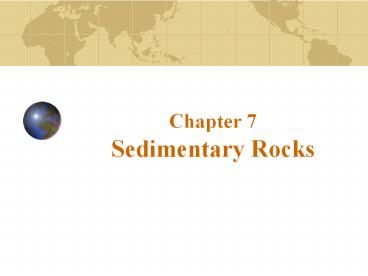Chapter 7 Sedimentary Rocks - PowerPoint PPT Presentation
Title:
Chapter 7 Sedimentary Rocks
Description:
Chapter 7 Sedimentary Rocks What is a sedimentary rock? Sedimentary rocks are products of mechanical and chemical weathering They account for about 5 percent (by ... – PowerPoint PPT presentation
Number of Views:212
Avg rating:3.0/5.0
Title: Chapter 7 Sedimentary Rocks
1
Chapter 7 Sedimentary Rocks
2
What is a sedimentary rock?
- Sedimentary rocks are products of mechanical and
chemical weathering - They account for about 5 percent (by volume) of
Earths outer 10 miles - Contain evidence of past environments
- Provide information about sediment transport
- Often contain fossils
3
What is a sedimentary rock?
- Sedimentary rocks are important for economic
considerations because they may contain - Coal
- Petroleum and natural gas
- Sources of iron, aluminum, and manganese
4
Turning sediment into rock
- Many changes occur to sediment after it is
deposited - Diagenesis all of the chemical, physical, and
biological changes that take place after
sediments are deposited - Occurs within the upper few kilometers of Earths
crust
5
Turning sediment into rock
- Diagenesis
- Includes
- Recrystallization development of more stable
minerals from less stable ones - Lithification unconsolidated sediments are
transformed into solid sedimentary rock by
compaction and cementation - Natural cements include calcite, silica, and iron
oxide
6
Types of sedimentary rocks
- Sediment originates from mechanical and/or
chemical weathering - Rock types are based on the source of the
material - Detrital rocks transported sediment as solid
particles - Chemical rocks sediment that was once in
solution
7
Detrital sedimentary rocks
- The chief constituents of detrital rocks include
- Clay minerals
- Quartz
- Feldspars
- Micas
- Particle size is used to distinguish among the
various types of detrital rocks
8
Detrital sedimentary rocks
- Common detrital sedimentary rocks (in order of
increasing particle size) - Shale
- Mud-sized particles in thin layers that are
commonly referred to as laminea - Most common sedimentary rock
9
Shale containing plant remains
10
Detrital sedimentary rocks
- Sandstone
- Composed of sand-sized particles
- Forms in a variety of environments
- Sorting, shape, and composition of the grains can
be used to interpret the rocks history - Quartz is the predominant mineral
11
(No Transcript)
12
Detrital sedimentary rocks
- Conglomerate and breccia
- Both are composed of particles greater than 2mm
in diameter - Conglomerate consists largely of rounded gravels
- Breccia is composed mainly of large angular
particles
13
Conglomerate
14
Breccia
15
Chemical sedimentary rocks
- Consist of precipitated material that was once in
solution - Precipitation of material occurs in two ways
- Inorganic processes
- Organic processes (biochemical origin)
16
Chemical sedimentary rocks
- Common chemical sedimentary rocks
- Limestone
- Most abundant chemical rock
- Composed chiefly of the mineral calcite
- Marine biochemical limestones form as coral
reefs, coquina (broken shells), and chalk
(microscopic organisms) - Inorganic limestones include travertine and
oolitic limestone
17
Coquina
18
Fossiliferous limestone
19
Chemical sedimentary rocks
- Common chemical sedimentary rocks
- Dolostone
- Typically formed secondarily from limestone
- Chert
- Made of microcrystalline quartz
- Varieties include flint and jasper (banded form
is called agate)
20
Chemical sedimentary rocks
- Common chemical sedimentary rocks
- Evaporites
- Evaporation triggers deposition of chemical
precipitates - Examples include rock salt and rock gypsum
21
Chemical sedimentary rocks
- Common chemical sedimentary rocks
- Coal
- Different from other rocks because it is composed
of organic material - Stages in coal formation (in order)
- 1. Plant material
- 2. Peat
- 3. Lignite
- 4. Bituminous
22
Successive stages in coal formation
23
Classification of sedimentary rocks
- Two major textures are used in the classification
of sedimentary rocks - Clastic
- Discrete fragments and particles
- All detrital rocks have a clastic texture
- Nonclastic
- Pattern of interlocking crystals
- May resemble an igneous rock
24
(No Transcript)
25
Sedimentary environments
- A geographic setting where sediment is
accumulating - Determines the nature of the sediments that
accumulate (grain size, grain shape, etc.)
26
Sedimentary environments
- Types of sedimentary environments
- Continental
- Dominated by erosion and deposition associated
with streams - Glacial
- Wind (eolian)
- Marine
- Shallow (to about 200 meters)
- Deep (seaward of continental shelves)
27
Sedimentary environments
- Types of sedimentary environments
- Transitional (shoreline)
- Tidal flats
- Lagoons
- Deltas
28
Continental (left) and marine (right)
depositional environments
29
Sedimentary environments
- Sedimentary facies
- Different sediments often accumulate adjacent to
one another at the same time - Each unit (called a facies) possesses a
distinctive set of characteristics reflecting the
conditions in a particular environment - The merging of adjacent facies tends to be a
gradual transition
30
Sedimentary facies
31
Sedimentary structures
- Provide information useful in the interpretation
of Earth history - Types of sedimentary structures
- Strata, or beds (most characteristic of
sedimentary rocks) - Bedding planes that separate strata
- Cross-bedding
32
Sedimentary structures
- Types of sedimentary structures
- Graded beds
- Ripple marks
- Mud cracks
33
(No Transcript)
34
Ripple Marks
35
Fossils Evidence of past life
- By definition, fossils are the traces or remains
of prehistoric life now preserved in rock - Fossils are generally found in sediment or
sedimentary rock (rarely in metamorphic and never
in igneous rock)
36
Fossils Evidence of past life
- Geologically fossils are important for several
reasons - Aid in interpretation of the geologic past
- Serve as important time indicators
- Allow for correlation of rocks from different
places
37
Natural casts of shelled invertebrates
38
Dinosaur footprint in limestone
39
(No Transcript)





























